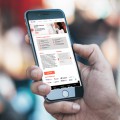How Facebook Designs for a Billion People
— May 4, 2015Margaret Gould Stewart, director of product design at Facebook, is an expert in designing for large-scale audiences. With experience from Google and YouTube, she brings deep insights into how major platforms create designs that serve billions. In her TED Talk, “How giant websites design for you (and a billion others, too),” she outlined lessons that businesses of any size can apply. Here are three key takeaways explained in detail.
Details Matter
Small design elements can have a tremendous impact. Take the Facebook “Like” button, for example. The team overseeing this button realized it needed an update to align with Facebook’s evolving brand identity. However, redesigning the button wasn’t straightforward. Several constraints made the task more complex, such as maintaining specific height and width dimensions, ensuring compatibility across languages, and preserving functionality on older web browsers. These limitations required the designers to avoid using advanced design techniques, like intricate gradients or borders, which wouldn’t display correctly in all environments.
Despite being a seemingly simple element, the redesign took approximately 280 hours to complete. Why devote so much time to a single button? The answer lies in the sheer visibility of this feature. The “Like” button appears 22 billion times daily on over 7.5 million websites. According to Stewart, it is one of the most viewed design components ever created.
This highlights the importance of sweating the small stuff. Even if your product or website doesn’t cater to billions of users, it will still be seen and interacted with. Every small element contributes to the overall experience and reflects your web application development project. Putting in the effort to fine-tune these details ensures that your product communicates your values effectively.
Ask Why, Over and Over
When something isn’t working, persistence is key. Stewart shared a story about Facebook’s photo reporting tool, which allowed users to flag images violating community guidelines. While many photos were reported, only a small percentage violated the platform’s standards. The majority were simply images users regretted sharing, like party pictures that no longer felt appropriate.
To address this, Facebook introduced a feature that allowed users to message friends directly, asking them to remove specific photos. However, only 20% of users took this step. The team didn’t stop there. They consulted conflict resolution experts and studied communication styles to uncover deeper insights. They found that the barrier was emotional. Users needed help expressing their feelings about the photo to their friends.
Facebook’s solution involved guiding users with suggested messages that conveyed their emotions. For example, users could send messages like:
“Hey ____, this photo is a little embarrassing to me, and I would prefer that people don’t see it on Facebook. Would you please take it down?”
This small change led to a significant improvement. The percentage of users sending these messages rose from 20% to 60%, and feedback revealed that both parties felt better about the interaction.
The lesson is clear: keep asking why. If a feature or process isn’t delivering results, don’t settle for the status quo. Experiment, analyze, and iterate until you find a solution that works. The extra effort can lead to transformative improvements.
Understand Your Audience
Designing for billions of users presents unique challenges. Many wonder why platforms like Facebook or Wikipedia don’t boast more visually striking designs, especially given the talented teams behind them. The answer lies in the diversity of their audience. These platforms are used by people worldwide, often under vastly different circumstances.
Margaret Gould Stewart illustrated this by asking: “What if you had to drive four hours to charge your phone because you had no reliable electricity?” Millions of users access Facebook on outdated or low-end devices. This reality necessitates designs that prioritize functionality and efficiency over flashy aesthetics. Mobile application development, in particular, plays a crucial role in making the platform accessible to everyone, regardless of their technological limitations.
To bridge this gap, Facebook designers take proactive steps to understand their audience better. They travel to various countries, use the platform in non-English languages, and test it on older devices to experience what users face firsthand. Stewart calls this practice “keeping in touch with others’ reality.”
The lesson here is to constantly consider who your product is for. While it’s natural to incorporate some of your own preferences into the design, focusing too much on personal tastes risks alienating your audience. By stepping outside your bubble and viewing your product through your users’ eyes, you can create experiences that truly resonate.
Conclusion
Good design goes beyond aesthetics. As Steve Jobs once said: “Design is not just what it looks like and feels like. Design is how it works.” Facebook’s approach to designing for billions exemplifies this philosophy. Whether by refining the tiniest elements, persistently questioning the effectiveness of features, or immersing themselves in their users’ realities, their design process emphasizes utility, empathy, and continuous improvement.
For businesses of any size, these principles offer valuable guidance. Pay attention to details, never stop iterating, and always prioritize your users’ needs. By doing so, you’ll not only create better products but also stand out in a competitive marketplace.






